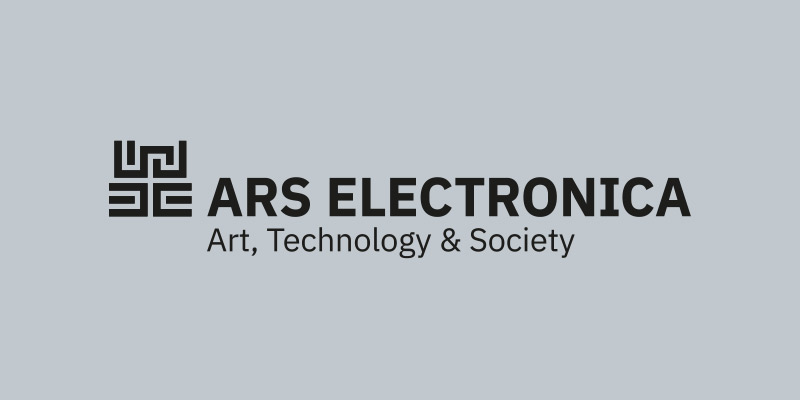Bio Art

Ars Electronica Futurelab: Bio Ink Experience
Wacom Co., Ltd. (JP) Yoko Shimizu (JP), Ars Electronica Futurelab
In the Bio Ink Experience, visitors draw and write with living ink comprised of various microorganisms. The data from Wacom pens and tablets is digitally extracted while the artworks morph into beautiful patterns in a new ecosystem of creativity. Bio Ink is part of the lab's Future Ink research project: To experience the latest developments, visit the brand-new exhibition on Life Ink in the Ars Electronica Center with prototype demonstrations and a performance during the Festival.

Residency. But How?
Christian Rauch (DE), Aimee Van Wynsberghe (CA), Irakli Sabekia (GE), Marjan Žitnik (HR), Robertina Šebjanič (SI)
Residencies bieten Künstler*innen und Wissenschaftler*innen die Möglichkeit, ihren jeweiligen Blickwinkel zu wechseln - von der Arbeit in einem Atelier zur Erprobung ihrer Fähigkeiten in einem Laborkontext und umgekehrt - und fördern so den Austausch von Ideen und die Entwicklung neuer konzeptioneller Modelle zur Problemlösung.

The Nature of Systems
Sebastian Pirch (AT), Norbert Unfug (AT), Christiane V. R. Hütter (AT), Jörg Menche (DE)
We live in the anthropocene, where human and natural ecosystems collide. In this interactive visualization, we explore the emergence and breakdown of complex systems from the cellular to the planetary scale. Life emerges from the interactions of biomolecules, cities from connecting people, the global society from sharing ideas. These systems can be beautiful, but also fragile.
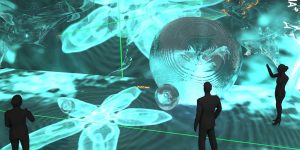
FRUIT ART... REAL Vs.-VIRTUAL LIFE (FA-RVsVR)
Franz Fischnaller (IT)
Exploring How Nature Makes Fiction Come Alive – 8K 3D Stereo Gigapixel immersive fruit art-based experience, gravitating around the invisible world of fruits. Visitors are virtually transferred “inside”.
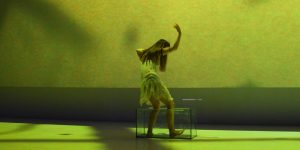
DANU
Smirna Kulenovic (BA), Damian Cortes-Alberti (AR), Julia Moser (AT), Alejandra Benet Garcia (ES), Laura Gagliardi (IT), Lucia Mauri (IT), Ariathney Coyne (EL/US), Alessia Rizzi (IT), Lina Pulido Barragan (CO), Sara Koniarek (AT), Maria Dierneder (AT), Felix Chang (AT), Daphne Xanthopoulou (EL)
We are all Bodies of Water: Re-enchanting the Vulva, re-spiriting the Danube, inviting the magic back into our oceanic beginnings. Entangled between our menstrual blood and primeval waters of Dānu, we embody our ancestral river myths through our common microbes, dancing. Leaking, sponging, and dissolving our human watery bodies, we invite the audience into a ritualistic gaze of interacting dependency — a mystical relationship with our larger, ecological, Bodies of Water.
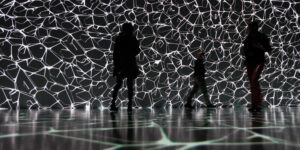
Cooperative Aesthetics Performance
Botond Kelemen (HU), Bálint Budai (HU), Daniel Haas (artistname STURMHERTA) (AT )
Mold yourself! Fungi have existed for billions of years, setting the stage for humanity by supporting, carrying and converting life. – Schwarzes Rauschen (Black Noise) The project is an immersive, interactive installation, consisting of 12 different, dynamic worlds, which change their structures with the movement of the group of people currently being tracked.
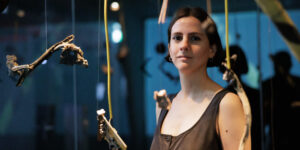
The Fallen Clouds
Josefina Buschmann (CL), Daniela Camino (CL), Nicole L’Huillier, Francisca Saéz(CL), Poli Mujica (CL)
The Fallen Clouds ist eine spekulative, forschungsbasierte Installation, die sich mit den sozio-ökologischen Auswirkungen digitaler Infrastrukturen in Chile befasst, indem sie einer "digitalen Cloud" auf der Suche nach ihrem Körper und Ursprung vom Pazifik bis zur Atacama-Wüste folgt.

ECOLALIA
Klaus Spiess (AT), Ulla Rauter (AT), Emanuel Gollob (AT), Rotraud Kern (AT)
Bis zum Jahr 2100 werden ein Drittel der biologischen Arten und neun Zehntel der Sprachen verschwunden sein. Unter dem Eindruck dieses gleichzeitigen Rückgangs der Vielfalt entwerfen wir ECOLALIA, eine Poesie des Aussterbens und Verschwindens, als einen tiefgreifenden Lernprozess, ausgehend von einer Echtzeit-Chemo-Vibrationskonditionierung der oralen Mikroben. Die Zuhörer*innen stimmen ihre Sprachlaute visuell und akustisch auf das Leben und Sterben ihrer fragilen Mundflora ab und werden so zu zweisprachigen Co-Autoren des Postanthropozäns.

